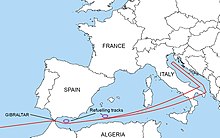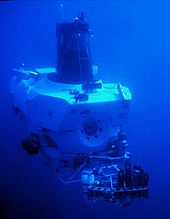1966 Palomares incident
The flight plan took the aircraft east across the Atlantic Ocean and Mediterranean Sea towards the European borders of the Soviet Union before returning home.[14] The aircraft and weapons fell to the ground near the fishing village of Palomares, part of the Cuevas del Almanzora municipality in Almeria province, Spain.The Navy convened a Technical Advisory Group (TAG), chaired by Rear Admiral L. V. Swanson with Dr. John P. Craven and Captain Willard Franklyn Searle, to identify resources and skilled personnel that needed to be moved to Spain.[22] After a search that continued for 80 days following the crash, the bomb was located by the DSV Alvin on 17 March, but was dropped and temporarily lost when the Navy attempted to bring it to the surface.According to Craven:[25] It is customary maritime law that the person who identifies the location of a ship to be salved has the right to a salvage award if that identification leads to a successful recovery.[27] To defuse public alarm over contamination, on 8 March[28] Spanish minister for information and tourism Manuel Fraga Iribarne and United States ambassador Angier Biddle Duke swam on nearby beaches in front of the press.This caused other nations hosting U.S. forces to review their policies, with Philippine Foreign Secretary Narciso Ramos calling for a new treaty to restrict the operation of U.S. military aircraft in Filipino airspace.[28] Palomares, and the Thule Air Base B-52 crash involving nuclear weapons two years later in Greenland, made Operation Chrome Dome politically untenable, leading the U.S. Department of Defense to announce that it would be "re-examining the military need" for continuing the program.[27] In 2004, a study revealed that there was still some significant contamination present in certain areas, and the Spanish government subsequently expropriated some plots of land which would otherwise have been slated for agriculture use or housing construction.[35] On 11 October 2006, Reuters reported that higher-than-normal levels of radiation were detected in snails and other wildlife in the region, indicating there may still be dangerous amounts of radioactive material underground.In April 2008, CIEMAT announced they had found two trenches, totaling 2,000 cubic metres (71,000 cu ft), where the U.S. Army stored contaminated earth during the 1966 operations.[38] In August 2010, a Spanish government source revealed that the U.S. had stopped the annual payments it has made to Spain, as the bilateral agreement in force since the accident had expired the previous year.Under a statement of intent signed by Spanish Foreign Minister José Manuel García-Margallo and U.S. Secretary of State John Kerry, the two countries were to negotiate a binding agreement to further restore and clear up the Palomares site and arrange for the disposal of the contaminated soil at an appropriate site in the U.S.[40] While serving on the salvage ship USS Hoist during recovery operations, Navy diver Carl Brashear had his leg crushed in a deck accident and lost the lower part of his left leg.[42] Marked long-term occurrences of cancer and other health defects occurred among the surviving USAF personnel directed to the accident site in the days following the crash to clean up the contamination.Most of the afflicted personnel have had difficulty securing any type of compensation from the Department of Veterans Affairs because of the secretive nature of the cleanup operation and the Air Force's refusal to acknowledge that adequate safety measures to protect first responders may not have been taken.[citation needed] This incident was given the movie treatment in a semi-serious 1967 film, The Day the Fish Came Out, which covers the story of a plane crash alongside a Greek (not Spanish) Island and the surreptitious attempts by plain-clothes U.S. Navy personnel to find the missing bombs.[citation needed] It is also referenced in Terence Young's 1969 drama The Christmas Tree, in which William Holden plays a rich industrialist, who, while traveling in Corsica with his son, learns the boy has been exposed to radiation from the explosion of a plane carrying a nuclear device; on the phone with a senior French official, he references the Palomares incident.[citation needed] The story was told in comic format as "Paco della Bomba" by Mino Milani on the Italian teenage-oriented magazine Corriere dei Ragazzi, on 12 January 1973.





B28FI nuclear bombUSS PetrelMid-air collisionMediterranean SeaPalomaresAlmeríaBoeing B-52G StratofortressStrategic Air CommandUnited States Air ForceRegistrationSeymour Johnson Air Force BaseNorth CarolinaKC-135 StratotankerMorón Air BaseKC-135 tankermid-air refuelingB28FI Mod 2 Y1thermonuclear (hydrogen) bombsplutoniumcontaminatedOperation Chrome Domeflight pathB28FI Mod 2 Y1 thermonuclear bombsCold WarSoviet Unionmid-air refuelingsKC-135longeronMorón Air BaseÁguilasairburstgroundburstlaydown groundburst deliveryW28 warheadCuevas del AlmanzoraAlmeria provinceradioactive contaminationJohn P. CravenWillard Franklyn SearleBayesian search theoryprobabilitiesUSS KiowaNavajo class fleet tugUSS MacdonoughUSS NimbleUSS PinnacleUSS RivalUSS SagacityUSS SaluteUSS SkillUSS NespelenUSS Fort SnellingUSS BostonUSS AlbanyUSS NotableJon LindberghUSS Plymouth RockUSS TringaUSS Charles R. WareUSS HoistUSS LindenwaldUSNS MizarUSNS DuttonDSV AlvinAluminautCURV-IUSS LuisenoUSS EvergladesUSNS Lt. George W. G. Boyceaircraft carrierUSS ForrestalSixth FleetUSS CascadeUnited States District Court for the Southern District of New YorkHerbert BrownellAttorney GeneralDwight D. Eisenhowersalvage rightsmaritime lawCommand PostSixteenth Air ForceTorrejón Air Basedirty bombpyrophoricManuel Fraga IribarneAngier Biddle DukeMojácarLyndon B. JohnsonNew York TimesWashington PostCommunistDuchess of Medina SidoniaLuisa Isabel Álvarez de ToledosocialistSpanish governmentFranco'sdictatorshipNATO'sGibraltar airstripPhilippineForeign SecretaryNarciso RamosThule Air Base B-52 crashGreenlandSavannah River PlantSouth CarolinaReutersCIEMATU.S. Department of EnergyamericiumMiguel Ángel MoratinosHillary ClintonJosé Manuel García-MargalloJohn KerryB28 nuclear bombsNational Museum of Nuclear Science & HistoryAlbuquerque, New MexicoCarl BrashearMen of HonorTime magazineDepartment of Veterans AffairsThe New York TimesCourt of Appeals for Veterans Claimsleukopeniacertify a classclass-action